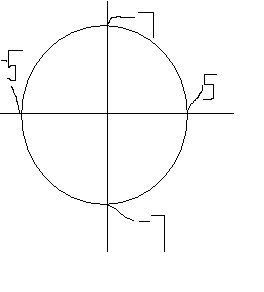circles in new lights
I tried to send this from word, but it didnt work at all. If I get it working, then this post will look better.
Today, we found a new light in the circle. The Ferris wheel was brought back, and we got Wednesday's quiz back. We went back to algebra and revived the ellipse.

There is your Ferris wheel. Isn't it beautiful? I made it in paint. Awesome...
Let’s say that the period for this function is 10 seconds. What would be the height at 5 seconds?
It would be the same as the initial height (1/2of a period)
How far to the left would the Ferris wheel be after 5 seconds?
The diameter....easy so far, right?
___________________________________________________________________
parametric equations to help with ellipses
first, to set your calculator:
Press mode and make sure you are in parametric (par) instead of function (func). Then make sure you are in degree mode.
Then to set your window: usually (at least for today), the window be 10x10. The t min and max should be 0 and 360 because one period is 360 degrees.
------------------------------------------------------------------------------------------------
Actual equations
now we move on to real work.
Put the equations x=5cos (t) and y=7sin (t)
your graph should look like this

Notice in the equation that cosine corresponds with the x coordinates, and sin corresponds with the y coordinates.
Also, note that the ellipse moves from -5 to 5 on the x axis and from 7 to -7 on the y axis. The x axis is limited the way it is shown because the equation is 5cos (t). The 5 half of the x-axis diameter as the 7 in the sin equation shows half of the y axis diameter.
Now as you can see, the equations x=cos (t) and y=sin (t) produce a unit circle
lets try a different one. Let’s say for example....
we have an x axis diameter of 12, and a y axis diameter of 6.
What would the equation be?
Well....
you would need the radius instead of the diameter for both axis....so it would be x with a radius of 6, and the y axis with a diameter of 3.
What would the equations be then?
x=6cos (t)
y=3sin (t)
------------------------------------------------------------------------------------------------
how to convert this weird form to a normal one
ex. the two equations:
x=5cos (t)
y=7sin (t)
first, square everything. make the equations as follows:
x^2=5^2 〖cos〗^2 (t)
y^2=5^2 〖sin〗^2 (t)
x^2/5^2 =〖cos〗^2 (t)
y^2/7^2 =〖sin〗^2 (t)
combine them
x^2/5^2 +y^2/7^2 =〖cos〗^2 (t)+〖sin〗^2 (t)=1
final equation:
x^2/5^2 +y^2/7^2 =1
-------------------------------------------------------------------------------------------
now for shifting:
x=cos (t)+2
y=sin(t)-3
This would move the origin to the point (2,-3)
easy enough so far, right?
--------------------------------------------------------------------------------------------
now....if you want part of an ellipse:

in order to restrict the part of the circle, do the divide by the limit
ex. half of circle....lets say that this is a unit circle
x=(cos^2(t))/(t≥0 and t≤180)
there you go......
you can also put the restriction under the "y" equation.....doesn't matter at all.
----------------------------------------------------------------------------------------------
ok....question begins:
a. what is the equation for this in standard ellipse form
b. what would the 2 equations be if the origin was moved to (3, 4)
Lets say the X axis diameter is 8, and the y axis diameter is 10
solution:
a. The main way for this equation would be:
1= x^2/4^2 +y^2/5^2
b. if it is moved:
x=4cos+3
y=5sin+4
that it
--------------------------------------------------------------------------------------------
here is another source to help you refresh your memory on ellipses
http://www.webmath.com/ellipses.html
here is one of the greatest pictures ever
awesome pic

0 Comments:
Post a Comment
<< Home